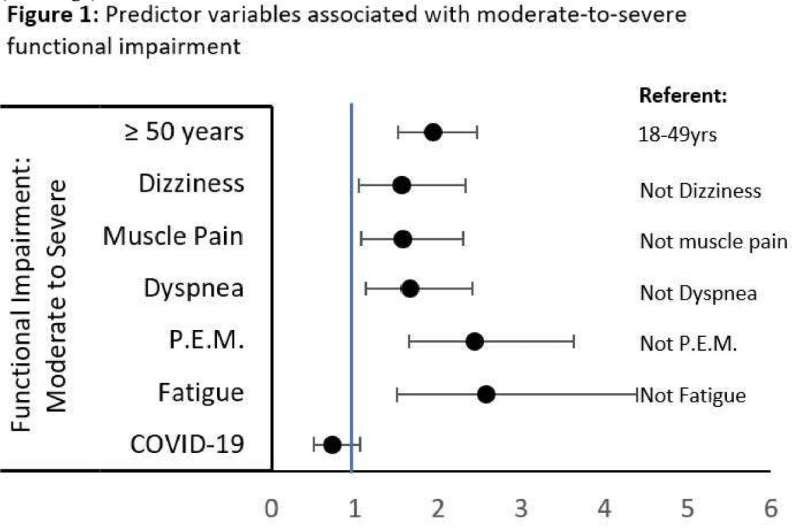This article has been reviewed according to Science X's editorial process and policies. Editors have highlighted the following attributes while ensuring the content's credibility:
fact-checked
peer-reviewed publication
proofread
Long COVID 'indistinguishable' from other post-viral syndromes a year after infection, researchers find

Long COVID appears to manifest as a post-viral syndrome indistinguishable from seasonal influenza and other respiratory illnesses, with no evidence of increased moderate-to-severe functional limitations a year after infection, according to new research being presented at this year's European Congress of Clinical Microbiology and Infectious Diseases (ECCMID 2024) in Barcelona, Spain (27-30 April).
The study by Queensland Health researchers suggests that in the highly vaccinated population of Queensland exposed to the omicron variant, long COVID's impact on the health system is likely to stem from the sheer number of people infected with SARS-CoV-2 within a short period of time rather than the severity of long COVID symptoms or functional impairment.
The findings add to previous research by the same authors and published in BMJ Public Health, which found no difference in ongoing symptoms and functional impairment when COVID-19 was compared with influenza 12 weeks post-infection.
Rates of long-term COVID-19 in Australia are low due to high vaccination rates upon easing of COVID restrictions and the population's subsequent exposure to the omicron variant. Symptoms reported with the illness include fatigue, brain fog, cough, shortness of breath, change to smell and taste, dizziness, and rapid or irregular heartbeat.
To understand more about the impact of long COVID on the Australian state of Queensland, researchers surveyed 5,112 symptomatic individuals aged 18 years and older, comprising those with PCR-confirmed infection for COVID-19 (2,399 adults) and those who were PCR negative for COVID-19 (2,713 adults: 995 influenza positive and 1,718 PCR negative for both but symptomatic with a respiratory illness) between 29 May and 25 June 2022.
Laboratory reporting for COVID-19 and influenza is mandated upon PCR test request under Queensland's public health legislation, with the results recorded in the Queensland Department of Health's Notifiable Conditions System.
A year after their PCR test, in May and June 2023, participants were asked about ongoing symptoms and the degree of functional impairment using a questionnaire delivered by SMS link.
Overall, 16% (834/5,112) of all respondents reported ongoing symptoms a year later, and 3.6% (184) reported moderate-to-severe functional impairment in their activities of daily life.
After controlling for influential factors including age, sex, and First Nation status, the analysis found no evidence that COVID-19 positive adults were more likely to have moderate-to-severe functional limitations a year after their diagnosis than symptomatic adults who were negative for COVID-19 (3.0% vs. 4.1%).
Moreover, results were similar when compared with the 995 symptomatic adults who had influenza (3.0% vs. 3.4%).
Interestingly, the analysis also found that those who were more likely to report moderate-to-severe functional impairment were those aged 50 years or older and those who had symptoms of dizziness, muscle pain, shortness of breath, post-exertional malaise, and fatigue.
"In health systems with highly vaccinated populations, long COVID may have appeared to be a distinct and severe illness because of high volumes of COVID-19 cases during the pandemic. However, we found that the rates of ongoing symptoms and functional impairment are indistinguishable from other post-viral illnesses," says Dr. John Gerrard, Queensland's Chief Health Officer.
"These findings underscore the importance of comparing post-COVID-19 outcomes with those following other respiratory infections and of further research into post-viral syndromes."
He adds, "Furthermore, we believe it is time to stop using terms like 'long COVID.' They wrongly imply there is something unique and exceptional about longer term symptoms associated with this virus. This terminology can cause unnecessary fear, and in some cases, hypervigilance to longer symptoms that can impede recovery."
The authors caution that the findings are associations and do not represent prevalence. They point to several limitations, including that participants who were hospitalized or had pre-existing illnesses were not identifiable within the cohort.
They also note that the risk of long COVID has been lower during the omicron wave compared with other SARS-CoV-2 variants, and because 90% of people in Queensland were vaccinated when omicron emerged, the lower severity of long COVID could be due to vaccination and/or the variant.
More information: Paper abstract: drive.google.com/file/d/12sjDX … 6W0y-WwLiGaRta_/view





















